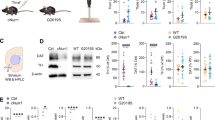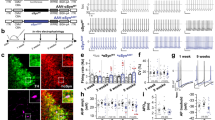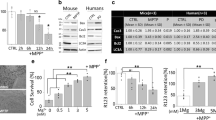Abstract
Dopaminergic (DA) neurons in substantia nigra pars compacta (SNc) are vulnerable to excitotoxicity in Parkinson’s disease (PD). Neurotoxic stimuli may alter the firing patterns of DA neurons. However, whether firing pattern change underlies neurotoxic stress-induced death of DA neurons remains unknown. In this study, we established long-term cultures of SNc organotypic slices and used this model to evaluate the neurotoxic effects on firing mode and DA neuronal viability following chronic treatment with neurotoxin 6-hydroxydopamine (6-OHDA). Using whole-cell patch clamp to explore the intrinsic membrane properties and firing mode, we showed that chronic exposure to 6-OHDA raised the resting membrane potential of SNc DA neurons and altered their firing pattern, causing it to switch from a regular rhythmic pacemaking firing to an irregular bursting. This firing pattern change correlated with increased death of SNc DA neurons. The 6-OHDA-induced firing pattern change correlated with an increase in the activity of the small conductance calcium-activated potassium channel (SK channel) and with an increase in both the level and activity of protein phosphatase 2A (PP2A). Activation of the SK channel by its agonist 1-EBIO attenuated 6-OHDA-induced firing irregularity and death, while the SK channel antagonist apamin exacerbated the toxic effects of 6-OHDA. Thus, SK channel current is a substantial element in sustaining the SNc DA neuronal rhythmic pacemaking and homeostasis and perturbing SK channel activity underlies 6-OHDA-induced neurotoxicity.






Similar content being viewed by others
References
Goldberg JA, Guzman JN, Estep CM, Ilijic E, Kondapalli J, Sanchez-Padilla J, Surmeier DJ (2012) Calcium entry induces mitochondrial oxidant stress in vagal neurons at risk in Parkinson’s disease. Nat Neurosci 15(10):1414–1421. doi:10.1038/nn.3209
Guzman JN, Sanchez-Padilla J, Chan CS, Surmeier DJ (2009) Robust pacemaking in substantia nigra dopaminergic neurons. J Neurosci 29(35):11011–11019. doi:10.1523/JNEUROSCI.2519-09.2009
Sah P, Faber ES (2002) Channels underlying neuronal calcium-activated potassium currents. Prog Neurobiol 66(5):345–353
Blythe SN, Wokosin D, Atherton JF, Bevan MD (2009) Cellular mechanisms underlying burst firing in substantia nigra dopamine neurons. J Neurosci 29(49):15531–15541. doi:10.1523/JNEUROSCI.2961-09.2009
Mrejeru A, Wei A, Ramirez JM (2011) Calcium-activated non-selective cation currents are involved in generation of tonic and bursting activity in dopamine neurons of the substantia nigra pars compacta. J Physiol 589(10):2497–2514
Cho S, Wood A, Bowlby MR (2007) Brain slices as models for neurodegenerative disease and screening platforms to identify novel therapeutics. Curr Neuropharmacol 5(1):19–33
Lu H-X, Levis H, Liu Y, Parker T (2011) Organotypic slices culture model for cerebellar ataxia: potential use to study Purkinje cell induction from neural stem cells. Brain Res Bull 84(2):169–173. doi:10.1016/j.brainresbull.2010.12.001
Kearns SM, Scheffler B, Goetz AK, Lin DD, Baker HD, Roper SN, Mandel RJ, Steindler DA (2006) A method for a more complete in vitro Parkinson’s model: slice culture bioassay for modeling maintenance and repair of the nigrostriatal circuit. J Neurosci Methods 157(1):1–9. doi:10.1016/j.jneumeth.2006.03.020
De Simoni A, Yu LM (2006) Preparation of organotypic hippocampal slice cultures: interface method. Nat Protoc 1(3):1439–1445. doi:10.1038/nprot.2006.228
Wang S, Ren P, Li X, Guan Y, Zhang YA (2011) 17beta-estradiol protects dopaminergic neurons in organotypic slice of mesencephalon by MAPK-mediated activation of anti-apoptosis gene BCL2. J Mol Neurosci 45(2):236–245. doi:10.1007/s12031-011-9500-z
Nihira T, Yasuda T, Hirai Y, Shimada T, Mizuno Y, Mochizuki H (2011) Adeno-associated viral vector-mediated gene transduction in mesencephalic slice culture. J Neurosci Methods 201(1):55–60. doi:10.1016/j.jneumeth.2011.07.010
Jourdi H, Hamo L, Oka T, Seegan A, Baudry M (2009) BDNF mediates the neuroprotective effects of positive AMPA receptor modulators against MPP+ -induced toxicity in cultured hippocampal and mesencephalic slices. Neuropharmacology 56(5):876–885. doi:10.1016/j.neuropharm.2009.01.015
Yang H, Shew WL, Roy R, Plenz D (2012) Maximal variability of phase synchrony in cortical networks with neuronal avalanches. J Neurosci 32(3):1061–1072. doi:10.1523/jneurosci.2771-11.2012
Masurkar AV, Chen WR (2011) Calcium currents of olfactory bulb juxtaglomerular cells: profile and multiple conductance plateau potential simulation. Neuroscience 192:231–246. doi:10.1016/j.neuroscience.2011.06.016
Xue WN, Wang Y, He SM, Wang XL, Zhu JL, Gao GD (2012) SK- and h-current contribute to the generation of theta-like resonance of rat substantia nigra pars compacta dopaminergic neurons at hyperpolarized membrane potentials. Brain Struct Funct 217(2):379–394. doi:10.1007/s00429-011-0361-6
Ibanez-Sandoval O, Carrillo-Reid L, Galarraga E, Tapia D, Mendoza E, Gomora JC, Aceves J, Bargas J (2007) Bursting in substantia nigra pars reticulata neurons in vitro: possible relevance for Parkinson disease. J Neurophysiol 98(4):2311–2323. doi:10.1152/jn.00620.2007
Overton PG, Clark D (1997) Burst firing in midbrain dopaminergic neurons. Brain Res Brain Res Rev 25(3):312–334
Bond CT, Maylie J, Adelman JP (2005) SK channels in excitability, pacemaking and synaptic integration. Curr Opin Neurobiol 15(3):305–311. doi:10.1016/j.conb.2005.05.001
Adelman JP, Maylie J, Sah P (2012) Small-conductance Ca2+-activated K+ channels: form and function. Annu Rev Physiol 74:245–269. doi:10.1146/annurev-physiol-020911-153336
Aumann TD, Gantois I, Egan K, Vais A, Tomas D, Drago J, Horne MK (2008) SK channel function regulates the dopamine phenotype of neurons in the substantia nigra pars compacta. Exp Neurol 213(2):419–430. doi:10.1016/j.expneurol.2008.07.005
Deignan J, Lujan R, Bond C, Riegel A, Watanabe M, Williams JT, Maylie J, Adelman JP (2012) SK2 and SK3 expression differentially affect firing frequency and precision in dopamine neurons. Neuroscience 217:67–76. doi:10.1016/j.neuroscience.2012.04.053
Benitez BA, Belalcazar HM, Anastasia A, Mamah DT, Zorumski CF, Masco DH, Herrera DG, de Erausquin GA (2011) Functional reduction of SK3-mediated currents precedes AMPA-receptor-mediated excitotoxicity in dopaminergic neurons. Neuropharmacology 60(7–8):1176–1186. doi:10.1016/j.neuropharm.2010.10.024
Berretta N, Freestone PS, Guatteo E, de Castro D, Geracitano R, Bernardi G, Mercuri NB, Lipski J (2005) Acute effects of 6-hydroxydopamine on dopaminergic neurons of the rat substantia nigra pars compacta in vitro. Neurotoxicology 26(5):869–881. doi:10.1016/j.neuro.2005.01.014
Wadsworth JDF, Torelli S, Doorty KB, Strong PN (1997) Structural diversity among subtypes of small-conductance Ca2+-activated potassium channels. Arch Biochem Biophys 346(1):151–160. doi:10.1006/abbi.1997.0280
Chung CY, Koprich JB, Endo S, Isacson O (2007) An endogenous serine/threonine protein phosphatase inhibitor, G-substrate, reduces vulnerability in models of Parkinson’s disease. J Neurosci 27(31):8314–8323. doi:10.1523/jneurosci.1972-07.2007
Cucchiaroni ML, Freestone PS, Berretta N, Viscomi MT, Bisicchia E, Okano H, Molinari M, Bernardi G, Lipski J, Mercuri NB, Guatteo E (2011) Properties of dopaminergic neurons in organotypic mesencephalic-striatal co-cultures—evidence for a facilitatory effect of dopamine on the glutamatergic input mediated by alpha-1 adrenergic receptors. Eur J Neurosci 33(9):1622–1636. doi:10.1111/j.1460-9568.2011.07659.x
Schiemann J, Schlaudraff F, Klose V, Bingmer M, Seino S, Magill PJ, Zaghloul KA, Schneider G, Liss B, Roeper J (2012) K-ATP channels in dopamine substantia nigra neurons control bursting and novelty-induced exploration. Nat Neurosci 15(9):1272–1280. doi:10.1038/nn.3185
Bezard E, Gross CE, Brotchie JM (2003) Presymptomatic compensation in Parkinson’s disease is not dopamine-mediated. Trends Neurosci 26(4):215–221. doi:10.1016/s0166-2236(03)00038-9
Bezard E, Boraud T, Bioulac B, Gross CE (1999) Involvement of the subthalamic nucleus in glutamatergic compensatory mechanisms. Eur J Neurosci 11(6):2167–2170
Ngo-Anh TJ, Bloodgood BL, Lin M, Sabatini BL, Maylie J, Adelman JP (2005) SK channels and NMDA receptors form a Ca2+-mediated feedback loop in dendritic spines. Nat Neurosci 8(5):642–649. doi:10.1038/nn1449
Allen D, Nakayama S, Kuroiwa M, Nakano T, Palmateer J, Kosaka Y, Ballesteros C, Watanabe M, Bond CT, Lujan R, Maylie J, Adelman JP, Herson PS (2011) SK2 channels are neuroprotective for ischemia-induced neuronal cell death. J Cereb Blood Flow Metab 31(12):2302–2312. doi:10.1038/jcbfm.2011.90
Gu N, Vervaeke K, Hu H, Storm JF (2005) Kv7/KCNQ/M and HCN/h, but not KCa2/SK channels, contribute to the somatic medium after-hyperpolarization and excitability control in CA1 hippocampal pyramidal cells. J Physiol 566(Pt 3):689–715. doi:10.1113/jphysiol.2005.086835
Dolga AM, Culmsee C (2012) Protective roles for potassium SK/K(Ca)2 channels in microglia and neurons. Front Pharmacol 3:196. doi:10.3389/fphar.2012.00196
Ji H, Hougaard C, Herrik KF, Strobaek D, Christophersen P, Shepard PD (2009) Tuning the excitability of midbrain dopamine neurons by modulating the Ca2+ sensitivity of SK channels. Eur J Neurosci 29(9):1883–1895. doi:10.1111/j.1460-9568.2009.06735.x
Waroux O, Massotte L, Alleva L, Graulich A, Thomas E, Liegeois JF, Scuvee-Moreau J, Seutin V (2005) SK channels control the firing pattern of midbrain dopaminergic neurons in vivo. Eur J Neurosci 22(12):3111–3121. doi:10.1111/j.1460-9568.2005.04484.x
Fakler B, Adelman JP (2008) Control of K(Ca) channels by calcium nano/microdomains. Neuron 59(6):873–881. doi:10.1016/j.neuron.2008.09.001
Sapolsky RM (2001) Cellular defenses against excitotoxic insults. J Neurochem 76(6):1601–1611. doi:10.1046/j.1471-4159.2001.00203.x
Fay AJ, Qian X, Jan YN, Jan LY (2006) SK channels mediate NADPH oxidase-independent reactive oxygen species production and apoptosis in granulocytes. Proc Natl Acad Sci U S A 103(46):17548–17553. doi:10.1073/pnas.0607914103
Dufour MA, Woodhouse A, Goaillard JM (2014) Somatodendritic ion channel expression in substantia nigra pars compacta dopaminergic neurons across postnatal development. J Neurosci Res. doi:10.1002/jnr.23382
Wolfart J, Neuhoff H, Franz O, Roeper J (2001) Differential expression of the small-conductance, calcium-activated potassium channel SK3 is critical for pacemaker control in dopaminergic midbrain neurons. J Neurosci 21(10):3443–3456
Acknowledgments
The authors wish to thank Zixu Mao from the Department of Pharmacology, Emory University School of Medicine for his advice and critical reading of the manuscript. The authors appreciate the work by MAXC (maxchelator.stanford.edu) in calculating calcium concentration. This work was supported by National Basic Research Program of China grant (973 Program, grant no. 2011CB510002) and National Natural Science Foundation of China grant (grant no. 31371400) to Qian Yang.
Conflict of Interest
The authors have no conflict of interest related to this study.
Author information
Authors and Affiliations
Corresponding author
Additional information
Yuan Wang, Liang Qu, and Xue-Lian Wang contributed equally to this study.
Electronic Supplementary Material
Below is the link to the electronic supplementary material.
Fig. 1
The viability of PC12 cells following 6-OHDA treatment and modulation of SK channel activity. A. Effects of modulation of SK channel activity on 6-OHDA-induced death. A representative image of TUNEL assay of PC12 cells treated with 6-OHDA (40 μM, 18 hrs) with or without 1-EBIO (10 μM, 18 hrs) or apamin (100 nM, 18 hrs) cotreatment (green: TUNEL staining; blue: DAPI; scale bar: 100 μm). B. Percentages of cells that are TUNEL positive following 6-OHDA treatment. PC12 cells were treated as described in A and scored for TUNEL positive percentage (averages are given as mean ± S.D). C. Quantification of PC12 cell viability following 6-OHDA treatment. PC12 cell viability was assessed by MTT analysis following treatment as described in A. Bars are mean ± S.D. (one-way ANOVA with Newman-Keuls Multiple Comparison Test: *P < 0.01 vs. control; # P < 0.05 vs. 6-OHDA) (GIF 79 kb)
Fig. 2
The effect of SK channel on 6-OHDA toxicity revealed by immunohistochemistry analysis. A Fluorescent images of TH (green) in cultured ventral mesencephalic slice: a control group, b 6-OHDA (25 μM), c 6-OHDA with Apamin (100 nM), d 6-OHDA with 1-EBIO (10 nM). Scare bar = 25 μm. B Quantitative analysis of the number of TH positive cells in different groups. Bars are mean ± S.D. (one-way ANOVA with Newman-Keuls Multiple Comparison Test: *P < 0.05 vs. control, # P < 0.05 vs. 6-OHDA) (GIF 356 kb)
Fig. 3
Plots of Ca2+ channel current versus time in SNc neurons, showing the increase of current amplitude induced by 0.5 mM 6-OHDA exposure (n = 8) (GIF 48 kb)
Rights and permissions
About this article
Cite this article
Wang, Y., Qu, L., Wang, XL. et al. Firing Pattern Modulation Through SK Channel Current Increase Underlies Neuronal Survival in an Organotypic Slice Model of Parkinson’s Disease. Mol Neurobiol 51, 424–436 (2015). https://doi.org/10.1007/s12035-014-8728-3
Received:
Accepted:
Published:
Issue Date:
DOI: https://doi.org/10.1007/s12035-014-8728-3




